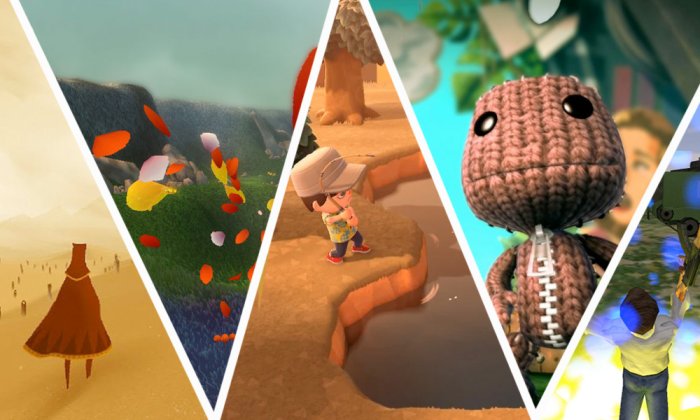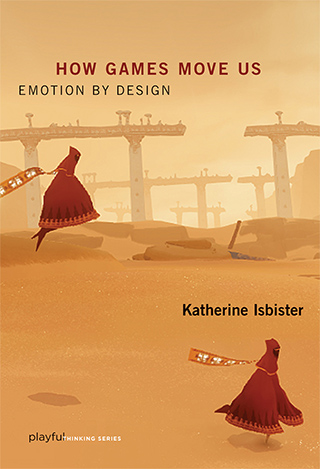How Games Move Us

“People talk about how games don’t have the emotional impact of movies. I think they do — they just have a different palette. I never felt pride, or guilt, watching a movie.”
—Will Wright, designer of The Sims
Compelling games don’t happen by accident, any more than do gripping novels, movies, or music. In all these media, creators draw from a well-defined set of strategies and techniques to create a specific emotional experience. Musicians, for instance, might use a minor key and slower tempo to create a sad or anxious mood (at least in the West). Film directors use close-ups to create intimacy. Game developers, too, have been honing techniques that lead players through intentionally designed emotional experience, whether that experience is the offbeat and comic mood of The Sims or Angry Birds, or the dramatic intensity of Call of Duty. But unlike film, fiction, or music, there isn’t yet a common language among designers, players, and society at large for what is going on and why in the hearts and minds of players.
At their heart, games differ from other media in one fundamental way: they offer players the chance to influence outcomes through their own efforts.1 With rare exception, this is not true of film, novels, or television. Readers and viewers of these other media follow along, reacting to the story and its twists and turns, without having a direct personal impact on the events they witness. In games, players have the unique ability to control what unfolds. As Sid Meier, designer of the best-selling game Civilization, once said, “a [good] game is a series of interesting choices.”2

Actions with consequences — interesting choices — unlock a new set of emotional possibilities for game designers. Ultimately, these possibilities exist because our feelings in everyday life, as well as games, are integrally tied to our goals, our decisions, and their consequences.3 People go through a rapid and automatic set of evaluations as things happen to them, about what each event might mean for their goals and plans. Emotions arise in the context of these appraisals, and help guide quick and appropriate actions. Psychology researchers focused on this appraisal process, in fact, have used videogames as research instruments, in order to tightly control situations and demonstrate how particular challenges lead to emotional responses. For example, adding events that match up to someone’s in-game goals reliably induces more pride and joy in players, while adding events that block their goals leads to anger.
Researchers can actually observe the traces of meaningful choices in the brain activity of gamers.
Researchers can actually observe the traces of meaningful choices in the brain activity of gamers. Neuropsychology researchers created an experiment in which some participants played a game and others watched a live video stream of another person playing (essentially like watching a movie). The researchers used fMRI equipment to get a glimpse of everyone’s brain activity. The active gamers showed more activation of “reward-related mesolimbic neural circuits” — parts of the brain associated with motivation and reward — than those who watched passively. Interacting with the game shifted the emotional patterns observed in the players’ brains, demonstrating how we human beings experience particular rewards and emotions from the act of playing.
To the human brain, playing a game is more like actually running a race than watching a film or reading a short story about a race. When I run, I make a series of choices about actions I will take that might affect whether I win. I feel a sense of mastery or failure depending on whether I successfully execute the actions in the ways I intended. My emotions ebb and flow as I make these choices and see what happens as a result. I feel a sense of consequence and responsibility for my choices. In the end, I am to blame for the outcomes, because they arise from my own actions. This rich set of feelings that I have about the solo experience of running depends on the active role that I play in the experience — that is, on my own meaningful choices.
Flow
The ability to choose and control your actions gives rise to the second unique quality of games: the ease with which players can enter a pleasurable, optimal performance state that psychology researcher Mihaly Csikzentmihalyi calls “flow.” When people are in flow — when musicians play at their best, when athletes are in “the zone,” when programmers stay up all night creating brilliant code — time seems to melt away and personal problems disappear. Well-designed games, with the control they offer users over actions in a novel world, readily engage players in a flow state.
When Csikzentmihalyi and his colleagues studied people in flow, they isolated eight factors defining this optimal state — factors that will sound familiar to anyone who finds games compelling.
- a challenging activity requiring skill
- a merging of action and awareness
- clear goals
- direct, immediate feedback
- concentration on the task at hand
- a sense of control
- a loss of self-consciousness
- an altered sense of time
The role of the flow state in games was not lost on Csikzentmihalyi. In his book “Finding Flow,” he calls out games, “developed over the centuries for the express purpose of enriching life with enjoyable experiences,” as excellent producers of flow in human beings.
Game designers such as Jenova Chen, who did his master’s thesis work on flow, have found flow theory useful in exploring the deeper “why” behind the fun players have with games. Chen intentionally tried to reproduce the eight major factors of flow in his game design practice. By doing so, he developed some famously engaging games including Journey. Chen believes flow theory provides a working model for game designers, encouraging them to keep players in a sweet spot where they have the right amount of ability to meet the challenges at hand. Too little ability can result in anxiety and frustration; too little challenge can result in boredom or apathy.
Increasingly, game designers aim to offer players interesting choices that fall within that sweet spot, generating flow. Flow theory has been a boon to the game design and research communities, moving discussion of what players feel and why away from the vague, if positive, notion of “fun” and into more nuanced emotional territory that can be shaped through design choices. When players discuss the emotions they feel when playing games,4 much of their vocabulary relates to flow (curiosity, excitement, challenge, elation, or triumph) or the lack thereof (frustration, confusion, discouragement). Thus, flow theory offers a useful lens for understanding the unique emotional power of games compared to other media.
Social Emotions
When designers offer interesting choices and keep players in flow, they’re able to also start evoking another class of feelings in their players — the rich social emotions we experience in relationship with others. In the 1980s, then fledgling game company Electronic Arts (EA) released an employee recruitment advertisement that asked “Can a Computer Make You Cry?” This phrase became a rallying cry for those in the game industry interested in creating social feelings in players such as affection, camaraderie, empathy, or even grief and sadness.
This was not an unreasonable question for EA to ask, given what was known about other media. Film and novels, for example, can evoke powerful social emotional responses. People read or watch or listen, start to feel immersed in the situation being presented/described, and then feel as if they were there. They begin to care about the characters and situations as if they were real. It is not uncommon, or shameful, to cry over something happening in a film or a book.
It’s also true that over time, some viewers/readers form powerful attachments to characters, a phenomenon known as “para-social interaction.” Media creators encourage these strong feelings of connection and cultivate them through strategic design elements. For example, TV hosts may make conversational asides to viewers to generate a feeling of intimacy and familiarity. Likewise, film directors often shoot at close range to create the illusion of intimate distance between the character and the viewer. Such techniques amplify identification with the virtual people and situations.
Experts in an area of psychology called “grounded cognition” argue that these techniques evoke emotion because they mirror the way our brains make sense of the world around us in everyday life. They posit that our brains compare what we sense and experience in any given moment to our past experiences (whether “real” or “mediated” — that is, created by media) in order to come up with a set of emotional and cognitive responses that are “grounded” in experience. So if we see or hear (or form a mental picture of) a person experiencing feelings in a social setting that we, too, are immersed in, our brains are “tricked” into believing that a real social experience is taking place. Of course we engage this delusion willingly — it allows us to experience alternate situations and ways of being human, which in turn informs our own experience of being human.
This tradition, as old as oral storytelling, still provides an effective way to share emotional and social wisdom and experience. Yet in any medium other than games, we are only witnesses, not actors, and cannot affect the outcomes of the stories before us.
Grounded cognition theory helps explain what it is about games that changes the range of emotional experiences possible for players when they take on an alternate identity or social situation during play. Consider this example that led to the epigraph from Will Wright, designer of the best-selling PC game franchise of all time, The Sims. Wright describes the first time he played Black and White: Creature Isle. In this game, the player has a creature that he trains, who acts as his go-between with the villagers in the game world. The player can mold an evil creature by treating it badly, or create a moral creature by treating it kindly.
A reader or filmgoer may feel many emotions when presented with horrific fictional acts on the page or screen, but responsibility and guilt are generally not among them.
Curious about the outcome of ill treatment, Wright began to slap his creature — then was astonished to find himself feeling guilty about it, even though this was very obviously not a real being with real emotions. This capacity to evoke actual feelings of guilt from a fictional experience is unique to games. A reader or filmgoer may feel many emotions when presented with horrific fictional acts on the page or screen, but responsibility and guilt are generally not among them. At most, they may feel a sense of uneasy collusion. Conversely, a film viewer might feel joyful when the protagonist wins, but is not likely to feel a sense of personal responsibility and pride. Because they depend on active player choice, games have an additional palette of social emotions at their disposal.
Brenda Brathwaite Romero’s Train offers an elegant example of a game that calls on interesting choices and the flow state to implicate players in social choices and outcomes. Winner of the Vanguard Award at IndieCade (the primary venue for showcasing independent games in the United States), this tabletop board game is part of Romero’s Mechanics Is the Message series. (A game mechanic is an action that a player can take that changes the game state.) She created these games specifically to evoke a feeling difficult to achieve in other media — complicity.

Players of Train move boxcars full of passengers from one place to another, dealing with obstacles and challenges along the way. Only at the end of the game do they learn the train’s destination: Auschwitz. Some players realize what’s happening midgame and turn their attention to saving as many passengers as they can. Almost all players feel strong emotions after they have experienced the endgame, whether or not they realized what was going on in the midst of play. “Ultimately, I think the power of a game lies in its ability to bring us close to the subject. There is no other medium that has this power,” Romero says. “I saw people cry over Train, not just once, but multiple times. People watching, playing, those trying to save the passengers. That’s powerful, and it’s the medium that does that.”
In Train, Romero creates a tension by juxtaposing the satisfying, flow-style emotions the player feels while mastering the system and rules of the game with the negative emotions that arise from the social context of these actions. In this regard, Train can be seen as a meditation on similar painful and horrific emotional juxtapositions that may have occurred in the actual historical situation.
Romero’s other board games in the Mechanics Is the Message series are equally stark and simple, encouraging a focus on the systems and rules of games that works to forge complicity. They bring home the power of games, whether digital or not, to evoke deep, socially based emotions triggered by choice and consequence.
Katherine Isbister is a game and human computer interaction researcher and designer, currently a professor in computational media at the University of California, Santa Cruz. She is the author of “How Games Move Us,” from which this article is excerpted.
- Katie Salen and Eric Zimmerman, Rules of Play: Game Design Fundamentals (Cambridge, MA: MIT Press, 2004). Jesper Juul, Half-Real: Video Games between Real Rules and Fictional Worlds (Cambridge, MA: MIT Press, 2005)
- Andrew Rollings and Dave Morris, Game Architecture and Design (Scottsdale, AZ: Coriolis, 2000)
- Phoebe C. Ellsworth and Klaus Scherer, “Appraisal Processes in Emotion,” in Handbook of Affective Sciences 572 (2003): V595
- Nicole Lazzaro, “The Four Fun Keys,” in Game Usability: Advice from the Experts for Advancing the Player Experience, ed. Katherine Isbister and Noah Schaffer (Burlington, MA: Morgan Kaufmann, 2008), 317–343



